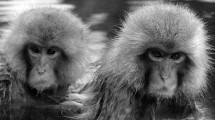Abstract
The paper examinesBateson’s idea that social relationships can be described according to the degree that behavior is symmetric (mutual) or complementary (non-mutual). It was suggested that in primates complementary relationships are most typical and stable.Bateson’s definitions were quantified and applied to observations of paired rhesus females, showing that familiar dyads had complementary relationships, probably reflecting social status, while unfamiliar dyads had symmetric relationships.
Similar content being viewed by others
References
Altmann, S. A., 1965. Sociobiology of rhesus monkeys. II: Stochastics of social communication.J. Theor. Biol., 8: 490–522.
Bateson, G., 1972.Steps to an Ecology of Mind. Ballantine, N. Y.
Bernstein, I. S., 1970. Primate status hierarchies. In:Primate Behavior, Vol. 1,L. A. Rosenblum (ed.), Academic Press, N. Y., pp. 71–109.
Hinde, R. A., in press. On describing relationships.J. Child Psychol. Psychiat.
————, 1971. Towards understanding individual differences in rhesus mother-infant interaction.Anim. Behav., 19: 165–173.
Kummer, H., 1968.Social Organization of Hamadryas Baboons. Univ. of Chicago Press, Chicago Ill.
Landau, H. G., 1951. On dominance relations and the structure of animal societies: I. Effect of inherent characteristics.Bull. Math. Biophys., 13: 1–19.
Slater, P. J. B., 1973. Describing sequences of behavior. In:Perspectives in Ethology, Vol. I,P. P. G. Bateson &P. H. Klopfer (eds.), Plenum Press, N. Y., pp. 131–153.
van Hooff, J. A. R. A. M., 1970. A component analysis of the structure of the social behavior of a semi-captive chimpanzee group.Experientia, 26: 549–550.
Wade, T. D., 1973. Concerning social organization and some factors which affect it in rhesus monkey groups. Unpublished doctoral dissertation, Rutgers Univ., Newark, N. J.
Author information
Authors and Affiliations
Additional information
Phases of this project were supported by U. S. P. H. S. grants, MH-17052 (toE. W. Hansen) and MH-00322 (Postdoctoral Fellowship).
About this article
Cite this article
Wade, T.D. Complementarity and symmetry in social relationships of nonhuman primates. Primates 18, 835–847 (1977). https://doi.org/10.1007/BF02382934
Received:
Accepted:
Issue Date:
DOI: https://doi.org/10.1007/BF02382934




